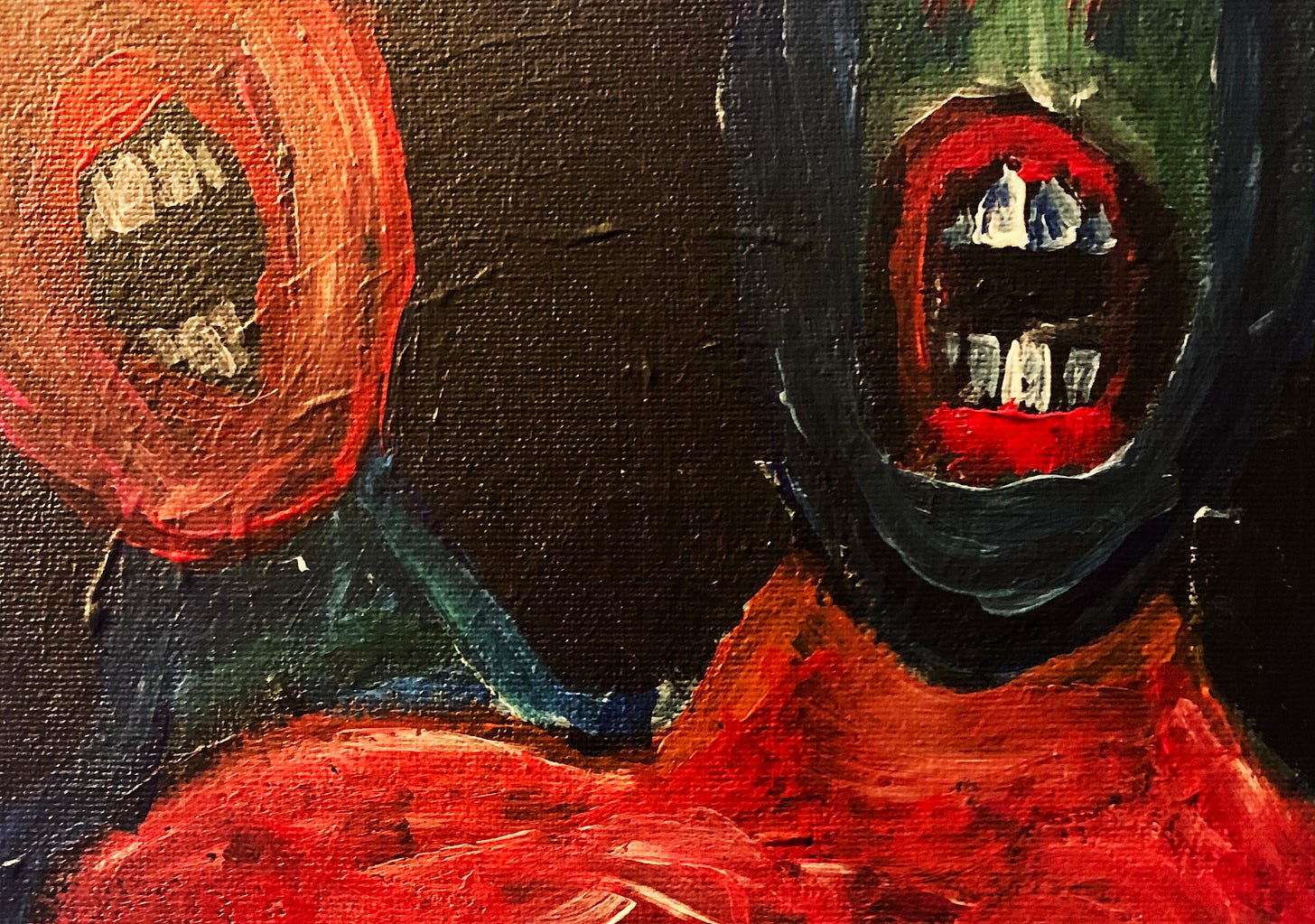Weaponizing the Trauma Vortex (with Claudia Black)
We are a world in trauma, and that trauma is being used against us.
In the introduction to Dirty Rubles—published four years ago (!) next month—I wrote:
Donald Trump is nothing less than a threat to the American way of life. His term in office comprises an existential threat to the republic, the gravest since the Civil War. Not since 1860 has the future of the Union itself been in such doubt. Other presidents might have lacked good judgment, but we never questioned where their true loyalties lay. George W. Bush loved America, Richard Nixon loved America, Herbert Hoover and Warren G. Harding loved America. Trump loves only himself, cares only about himself, is loyal only to himself. And Vladimir Putin has exploited this weakness, to the detriment of not just every American, but every freedom-loving human being on earth.
I was hardly the only observer to warn of the dire threat to the republic Trump represented. I saw, as many others did, that dark days were ahead. But I did not anticipate quite so many of them: The assault on our sacred institutions, on women and people of color and the LGBTQ community, on common decency. The pandemic. The quarantine. The first impeachment. The insurrection. The second impeachment. The dickering around on Twitter, watching a handful of lawyers argue about whether or not Merrick Garland is in fact investigating the coup plotters, wondering if democracy will die before the DOJ springs into action. And now, Putin’s heinous war of aggression in Ukraine.
Individually, these were all traumatizing events, each one powerful on its own. But all of them happening more or less simultaneously? That’s what the trauma specialist Claudia Black, today’s guest on the PREVAIL podcast, calls a “trauma turducken”—trauma upon trauma upon trauma.
“What we’re seeing in this really dysregulated collective in America is really undigested fight, flight, or freeze,” Black says. This explains, at least in part, why a third of the country is behaving so irrationally. “The people who are going off on the Convoy to do something probably had an experience where they had a thwarted fight response. They were in an aggressive situation at some point in their lives, and they tried to fight, and they didn’t succeed. And now they have this fight energy that they don’t know what to do with that’s still in their nervous system from years ago. This is simplifying things, but honestly can be that—we can look at it through that lens and understand a lot of this very easily.”
Needless to say, it doesn’t help matters when people who are already badly traumatized suffer more trauma.
“The best option for humans in general, and animals, is fleeing,” she says, “the flight response. But if our ability to flee is thwarted, we’re going to have all of that adrenalin and cortisol and all of those hormones that recruit to get us out of there, trapped in the system—because we didn’t succeed in trying to run away, to begin with. And then we probably wound up in a freeze response after that. And as a result, we have all of that adrenalin, and all of that fear and hopelessness and helplessness trapped in the system. So what people wind up with all the time is learnt hopelessness, learnt helplessness, shame, fear—all of this stuff, still, like a layer cake, in their soma.”
Soma is not the happy drug from Brave New World, but rather the body of a living creature—as distinct from the mind. It is also the root word for Somatic Experiencing, the kind of body-centered trauma resolution therapy that Black studies.
“When we’re in our lizard brains, our amygdala can’t discern between time and space,” she tells me. “We can’t discern whether [the trauma] is happening now, or it’s a trigger from a past event. So we’re operating—a lot of people in the collective—from their sense of perceived threat.
“And Russia and all of these bad actors [here] have created great narratives around perceived threat. They’re finding scapegoats all over the place, and the minute we have these identified scapegoats, they’re a perceived threat. And the minute it triggers something in our nervous system that there’s a perceived threat, we go into the physiology that’s a response to threat. And that’s unsustainable. It makes us incredibly unwell. It wears us out. And it makes us—we’re not operating from our executive function, from our neo-cortex, so we’re making very primal, basic, antisocial decisions based on the fact that our nervous systems think we’re under threat from something.”
Complicating matters is the fact that, while bad actors are indeed knowingly weaponizing our trauma, we are under threat from something. The pandemic has not gone away. Not just in the United States, but all around the world, democracy is under attack. Despotic forces home and abroad are ready to take advantage of a population in freeze response. If Putin’s war crimes in Ukraine can be said to have any purpose, it is to traumatize the Ukrainians so badly that they surrender.
So-called “disaster capitalists” wait like vultures to pounce on their traumatized prey. Naomi Klein articulated this strategy in her seminal book The Shock Doctrine: “waiting for a major crisis, then selling off pieces of the state to private players while citizens were still reeling from the shock, then quickly making the ‘reforms’ permanent.”
Free market apostles of the hateful economist Milton Friedman applied this ugly strategy in Chile under Pinochet, in Iraq after the U.S. invasion, in Sri Lanka after the tsunami of 2004, and, yes, in Russia in 1993. “[I]t was Boris Yeltsin’s decision,” Klein notes, “to send in tanks to set fire to the parliament building and lock up the opposition leaders that cleared the way for the fire-sale privatization that created the country’s notorious oligarchs.”
Trauma upon trauma upon trauma.
Black recalls something she was taught by her teacher, trauma expert Gina Ross, who coined the term “trauma vortex:” “She was saying, look, you need to be responsible for the news you’re getting out there, the content you’re putting out there, the way you frame things, because you can either keep retraumatizing people—you can either be part of the trauma vortex, as she calls it—or be part of the healing vortex. And there’s a way of communicating that supports one or the other.
“We have been in, to a great extent, this turducken of trauma in America because we’ve been weaponizing the trauma vortex—deliberately. And Russia’s been so clever at that, you know. They’ve always been good at the psyops, they’ve always been good at psychological manipulation and mind games, all of that technology, all of those trolls, they’re always been ahead of the game in that regard. And they’ve weaponizing social media specifically for that purpose. Because the more binary we become in our thinking, the more simplified everything becomes, the more reductive everything becomes, the easier we are to manipulate, right?”
In others words, Putin and his American collaborators are using trauma as a weapon against us. When, say, Tucker Carlson taps into white male grievance, what he’s really doing is accessing the trauma of his audience. This is intentional. It is ugly. And it must stop.
LISTEN TO THE PODCAST
S3 E3: The Trauma Vortex (with Claudia Black)
Trump, the assault on common decency, pandemic, quarantine, insurrection, and now war: we have all suffered collective trauma these last five years. Greg Olear talks with actor and trauma therapist Claudia Black about the causes of trauma and how to heal from it. Plus: DFG sings.
Follow Claudia:
https://twitter.com/TheClaudiaBlack
Her site [note: will be available soon]:
http://www.claudiablackconsulting.com
Photo credit: M. Olear, untitled paint on canvas, and fdecomite, Doyle spiral.






WOW, nailed it again. Never in my long life did your words ring truer.
And yet another WOW! Yes, what Jeri said. You nailed it Greg. Wow. We have so much work to un-do.